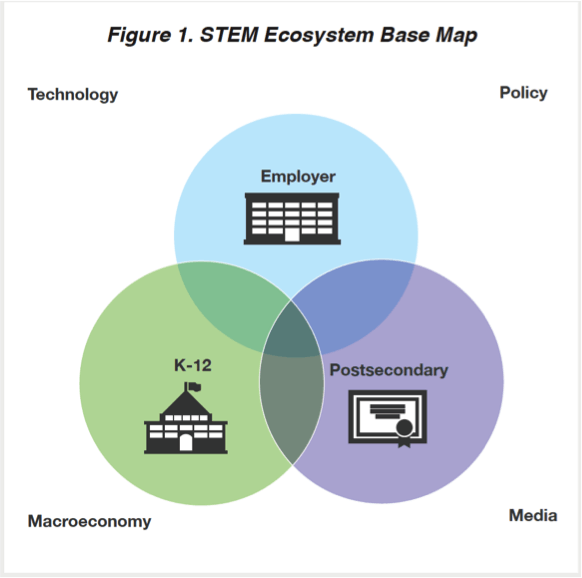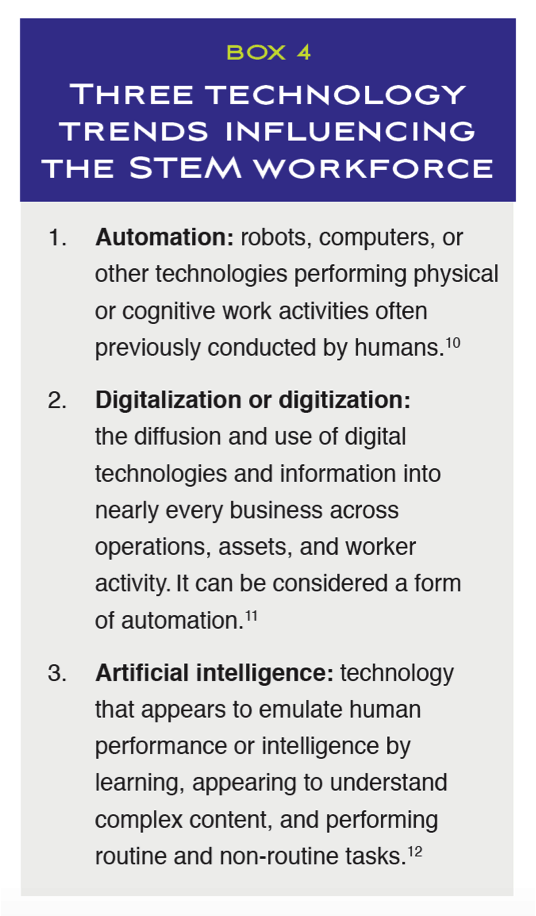STEMconnector released the State of STEM report in May of this year, and we continue to use the framework and research to drive knowledge and action for our networks. We are pleased to share a series of blog posts diving more deeply into the resources found in the call-out boxes included throughout the report. This third piece focuses on Box 4: Three Technology Trends Influencing the STEM Workforce (page 6 of the report) and provides context to each trend’s role in the STEM ecosystem.
As noted in State of STEM, technology is a prominent external force influencing the different sectors within the STEM ecosystem (see Figure 1 below and on page 6 of the report). The increase in automation, digitalization, and artificial intelligence affects everyone in the ecosystem – students, educators, and employers – and calls for greater understanding and collaboration among these stakeholders to ensure learning, teaching, and hiring are aligned in creating a workforce reflective of the needs of the evolving economy. To do so, each sector needs to reach a basic, common understanding of the three major technology trends influencing the STEM workforce:
- Automation, defined as the process in which robots, computers, or other technologies performing physical or cognitive work activities often previously conducted by humans.
- Additional reading: Will robots and AI take your job? The economic and political consequences of automation (Brookings Institute)
- Digitalization or digitization, defined as the the diffusion and use of digital technologies and information into nearly every business across operations, assets, and worker activity. It can be considered a form of automation.
- Additional reading: Understanding the impact of digitalization on society (World Economic Forum)
- Artificial intelligence, defined as technology that appears to emulate human performance or intelligence by learning, appearing to understand complex content, and performing routine and non-routine tasks.
- Additional reading: The evolution of employment and skills in the age of AI (McKinsey & Company)
 While employers may seem most affected by shifts in technology, K-12 and postsecondary educational institutions are also faced with big questions regarding changes in curriculum and the role of education in supporting new skill requirements for the workforce. Educators are constantly challenged with determining the type of knowledge students need to succeed in a technology-saturated society. While tempting to simply require students to learn each new coding language, students should be equipped to become lifelong learners who can adapt as technology evolves.
While employers may seem most affected by shifts in technology, K-12 and postsecondary educational institutions are also faced with big questions regarding changes in curriculum and the role of education in supporting new skill requirements for the workforce. Educators are constantly challenged with determining the type of knowledge students need to succeed in a technology-saturated society. While tempting to simply require students to learn each new coding language, students should be equipped to become lifelong learners who can adapt as technology evolves.
Dan Barstow, Education Manager for the International Space Station, summarizes the new demands placed on employers and employees in this new realm of technological sophistication: “in the era of Google, we don’t need people who can memorize, we need people who can think” (page 14 of State of STEM). Determining when and how to build the knowledge, skills, and mindsets needed along STEM talent pathways will be key to success for both employers and employees.
